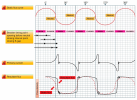Joe my AP/IA came by and confirmed what I was thinking. It was retarded 2 degrees at 23. Not sure how it got like that. Mag was tight and the nuts were still torqued as I checked them before loosing them.
2° in 230 hours isn't bad. You're seeing some points rubbing block wear. The larger problem is that the E-gap gets thrown off, and the spark is weakened. The E-Gap is the angle after rotor neutral at which the points open. At the correct angle, or E-gap, the distance the flux falls is maximized and the hottest spark produced. Resetting that is a pain in a TCM/Bendix mag.

The static flux is the magnetic flux generated in the magneto's core as the magnet in the rotor turns. The resultant flux is the flux in the core due to the current generated in the primary winding; the inductance of that winding keeps the current flowing after the magnet has reached neutral, and that continuing current flow generates a continuing flux. The points open at the E-gap, the flux falls a long way to below neutral, and that rapidly collapsing magnetic field generates the high spark voltage in the secondary winding.
If the points open later, the E-gap moves farther from the 90/270 rotor neutral positions, the flux has been decreasing on its own (see the slight downward curve developing just before points open), the distance it falls is less and the secondary voltage suffers.
While we're at it, we might as well mention the condenser (capacitor). Some think it's to prevent arcing and burning of the points, but just try running without it. If the primary current arcs across the points as they open, that represents continued current flow right when we want to arrest it suddenly to get the rapid collapse of the field. So the flux curves off gradually and you get little or no spark. The condenser will absorb current flow after the points open, but it is soon full, and by that time the points are too far apart to arc, so the currents stops dead and the field collapses.
There is nothing in the mag that doesn't absolutely need to be there.
Pilots that want to know more about the workings of their airplanes should get this book:

Some pilot shops have it. Amazon has it. If you buy it I can post a corrections page for it, though this issue is newer than the one I used as a textbook for my college class. The mistakes might be corrected.











